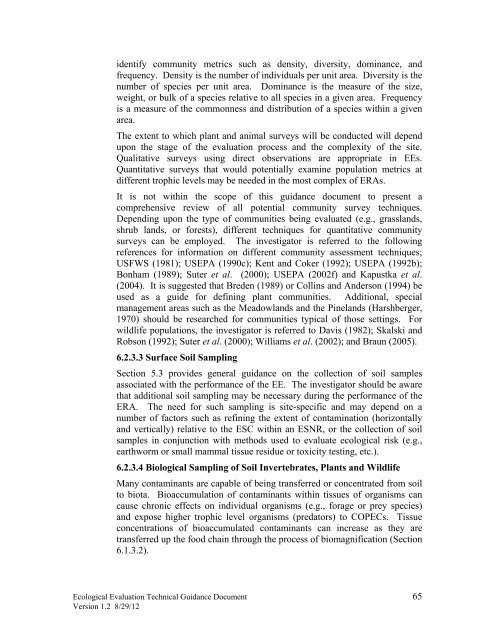Ecological Evaluation Technical Guidance - State of New Jersey
Ecological Evaluation Technical Guidance - State of New Jersey
Ecological Evaluation Technical Guidance - State of New Jersey
- No tags were found...
You also want an ePaper? Increase the reach of your titles
YUMPU automatically turns print PDFs into web optimized ePapers that Google loves.
identify community metrics such as density, diversity, dominance, andfrequency. Density is the number <strong>of</strong> individuals per unit area. Diversity is thenumber <strong>of</strong> species per unit area. Dominance is the measure <strong>of</strong> the size,weight, or bulk <strong>of</strong> a species relative to all species in a given area. Frequencyis a measure <strong>of</strong> the commonness and distribution <strong>of</strong> a species within a givenarea.The extent to which plant and animal surveys will be conducted will dependupon the stage <strong>of</strong> the evaluation process and the complexity <strong>of</strong> the site.Qualitative surveys using direct observations are appropriate in EEs.Quantitative surveys that would potentially examine population metrics atdifferent trophic levels may be needed in the most complex <strong>of</strong> ERAs.It is not within the scope <strong>of</strong> this guidance document to present acomprehensive review <strong>of</strong> all potential community survey techniques.Depending upon the type <strong>of</strong> communities being evaluated (e.g., grasslands,shrub lands, or forests), different techniques for quantitative communitysurveys can be employed. The investigator is referred to the followingreferences for information on different community assessment techniques;USFWS (1981); USEPA (1990c); Kent and Coker (1992); USEPA (1992b);Bonham (1989); Suter et al. (2000); USEPA (2002f) and Kapustka et al.(2004). It is suggested that Breden (1989) or Collins and Anderson (1994) beused as a guide for defining plant communities. Additional, specialmanagement areas such as the Meadowlands and the Pinelands (Harshberger,1970) should be researched for communities typical <strong>of</strong> those settings. Forwildlife populations, the investigator is referred to Davis (1982); Skalski andRobson (1992); Suter et al. (2000); Williams et al. (2002); and Braun (2005).6.2.3.3 Surface Soil SamplingSection 5.3 provides general guidance on the collection <strong>of</strong> soil samplesassociated with the performance <strong>of</strong> the EE. The investigator should be awarethat additional soil sampling may be necessary during the performance <strong>of</strong> theERA. The need for such sampling is site-specific and may depend on anumber <strong>of</strong> factors such as refining the extent <strong>of</strong> contamination (horizontallyand vertically) relative to the ESC within an ESNR, or the collection <strong>of</strong> soilsamples in conjunction with methods used to evaluate ecological risk (e.g.,earthworm or small mammal tissue residue or toxicity testing, etc.).6.2.3.4 Biological Sampling <strong>of</strong> Soil Invertebrates, Plants and WildlifeMany contaminants are capable <strong>of</strong> being transferred or concentrated from soilto biota. Bioaccumulation <strong>of</strong> contaminants within tissues <strong>of</strong> organisms cancause chronic effects on individual organisms (e.g., forage or prey species)and expose higher trophic level organisms (predators) to COPECs. Tissueconcentrations <strong>of</strong> bioaccumulated contaminants can increase as they aretransferred up the food chain through the process <strong>of</strong> biomagnification (Section6.1.3.2).<strong>Ecological</strong> <strong>Evaluation</strong> <strong>Technical</strong> <strong>Guidance</strong> Document 65Version 1.2 8/29/12
















